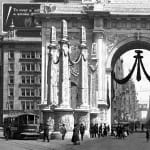 "Triumph and Remembrance: The Victory Arch at Madison Square, New York City, 1919" (watermarks do not appear on the actual artwork.)
"Triumph and Remembrance: The Victory Arch at Madison Square, New York City, 1919" (watermarks do not appear on the actual artwork.)
 "Triumph and Remembrance: The Victory Arch at Madison Square, New York City, 1919" (watermarks do not appear on the actual artwork.)
"Triumph and Remembrance: The Victory Arch at Madison Square, New York City, 1919" (watermarks do not appear on the actual artwork.)
 "Triumph and Remembrance: The Victory Arch at Madison Square, New York City, 1919" (watermarks do not appear on the actual artwork.)
"Triumph and Remembrance: The Victory Arch at Madison Square, New York City, 1919" (watermarks do not appear on the actual artwork.)
 "Triumph and Remembrance: The Victory Arch at Madison Square, New York City, 1919" (watermarks do not appear on the actual artwork.)
"Triumph and Remembrance: The Victory Arch at Madison Square, New York City, 1919" (watermarks do not appear on the actual artwork.)
 "Triumph and Remembrance: The Victory Arch at Madison Square, New York City, 1919" (watermarks do not appear on the actual artwork.)
"Triumph and Remembrance: The Victory Arch at Madison Square, New York City, 1919" (watermarks do not appear on the actual artwork.)
 "Triumph and Remembrance: The Victory Arch at Madison Square, New York City, 1919" (watermarks do not appear on the actual artwork.)
"Triumph and Remembrance: The Victory Arch at Madison Square, New York City, 1919" (watermarks do not appear on the actual artwork.)
 "Triumph and Remembrance: The Victory Arch at Madison Square, New York City, 1919" (original vintage glass camera negative, not for sale, display only.)
"Triumph and Remembrance: The Victory Arch at Madison Square, New York City, 1919" (original vintage glass camera negative, not for sale, display only.)
"Triumph and Remembrance: The Victory Arch at Madison Square, New York City, 1919", 1919
Further images
In the spring of 1919, New York City became a stage of both jubilation and sorrow. At the southern end of Fifth Avenue, a grand Victory Arch rose in Madison Square — a monumental gateway built to honor the heroes of World War I and to welcome home the American Expeditionary Forces who had fought on distant battlefields.
Designed by Thomas Hastings of Carrère & Hastings, the celebrated architect of the New York Public Library, the temporary arch was inspired by the ancient Arch of Constantine in Rome. Constructed of wood and plaster but conceived with classical grandeur, it was draped in black mourning bunting and adorned with allegorical sculptures symbolizing Victory, Peace, and Valor. For one luminous year, it transformed Madison Square into a temple of remembrance — a meeting place of gratitude and grief.
On March 25, 1919, the Victory Parade thundered up Fifth Avenue. Tens of thousands of soldiers — including the famed 77th Division, the “Statue of Liberty Division” of New York — marched beneath the arch as brass bands played and confetti rained from the rooftops. Crowds wept and cheered as the city celebrated triumph, mourned its fallen, and embraced the peace hard-won.
Though dismantled in 1920, the Victory Arch remains one of New York’s most powerful lost landmarks — a fleeting masterpiece of Beaux-Arts patriotism and emotional unity. This rare historic photograph captures that singular moment when architecture, art, and human spirit joined to celebrate victory, honor sacrifice, and mark the dawn of a new century of hope.
Provenance
Past in Present.com Inc private historical archive.











